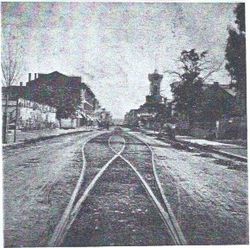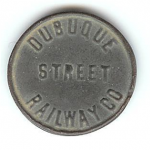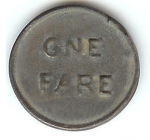Encyclopedia Dubuque
"Encyclopedia Dubuque is the online authority for all things Dubuque, written by the people who know the city best.”
Marshall Cohen—researcher and producer, CNN
Affiliated with the Local History Network of the State Historical Society of Iowa, and the Iowa Museum Association.
DUBUQUE STREET RAILWAY COMPANY
DUBUQUE STREET RAILWAY COMPANY. Organized on October 1, 1867, the company listed among its officers Platt SMITH, Julius K. GRAVES, Henry L. STOUT, and John THOMPSON. With capitalization at $75,000, contracts for building and supplying the route were signed with Charles Hathaway of Philadelphia, Pennsylvania.

By ordinance of October, 1867, the Dubuque Street Railway Company and their successors were granted "the exclusive right and privilege to construct, operate and maintain over the streets of the city of Dubuque street railways for carrying passengers and freight for the term of twenty years." (2) They were required to have at least two miles of track completed and in operation within one year. The first horse-powered STREETCARS ran from the southern terminus of the ferry landing below Jones Street to Main and then north along Main to Thirteenth, to Clay, Eighteenth, and Couler Avenue. Continuing northward, the route ended at the fair grounds.
The first work on the street railway was done late in November, 1867, near Heeb's brewery; the first section ended at TIVOLI GARDENS. Extensions could be run to EAGLE POINT and the driving park. (3)
Five cars began operations on May 23, 1868, with fifteen horses.
The company was leased to Platt Smith and James Hughes until 1876. Joseph H. RHOMBERG, John J. LINEHAN, and Bart E. LINEHAN then purchased the franchise and reduced the fare from ten cents to a nickel. For interested customers, twenty-four tickets could be purchased at one time for one dollars. (4) One of the changes proposed was a lunch table in each car with a keg of beer available. (5) Conductors on the cars were paid forty-five dollars per month. The streetcars, later equipped with storage batteries, ran their route so frequently that they passed each other every five minutes. A round trip took one hour.
In 1879 the railway had twenty-four horses supplied by the Tyler Brothers of Texas who were still supplying the animals in 1890. (6) Each traveled thirty-five miles daily. Feed for all the animals included fifteen bushels of oats daily and one ton of hay per week. (7)
By an act of July, 1883, additional rights and privileges were granted to the company and additional requirements were expected from it. (8)
The right-of-way granted to the company in April, 1890 along Rhomberg Avenue to Eagle Point required the firm to keep the street in good repair, make regular trips, and clear the lines of snow. More importantly, it stated that after January 1, 1891 the company had to change from "broncho" (horse) to some more modern system of power. (9)
Spurred by the demands of the council, the company moved quickly into action. It was announced that it would lay a track along side that of the DUBUQUE ELECTRIC RAILWAY, LIGHT AND POWER COMPANY along Couler Avenue to the city limits. (10) The city council, meeting as a committee of the whole, later in June 1890 decided to withhold this right-of-way until the company had proven itself able to operate its present lines with the conversion from "mule" to electric power. (11)
J. A. Rhomberg announced in July 1890 that a storage battery powered streetcar from Philadelphia would be brought to Dubuque within a week to test on his lines. (12) Named the "Edco" as an abbreviation of the Electro-Dynamic Company, the car reached Dubuque on July 30, 1890. (13) Representatives of the Accumulator Company of Boston announced the portable engine of thirty horsepower could reach a maximum speed of twelve miles per hour on level grades and climb any incline not exceeding 8%. The Dubuque Street Railway Company had an option on fifteen cars. A double set of batteries was purchased with each car so that one battery could be in use while the other was being charged. (14) It was estimated that a car could operate for fifty miles before batteries would need to be recharged. (15) The car was tested on August 8, 1890 and thrilled the crowds since it operated without horses or overhead wires. (16)
Rumors spread in August, 1889 that the Holmes Syndicate of Chicago had offered to purchase the company. J. A. Rhomberg quickly responded that there was no truth to the stories. Although Holmes was building an electric line in Stillwater, Minnesota, Rhomberg contended there was not room in Dubuque was such an operation and not enough passengers to support two lines. (17)
In August, 1890, the company was granted the right to erect an electric light and power station within the city limits, and was limited to twenty-five years duration. By ordinance of September, 1890, the company was permitted to lay and maintain a double track on certain streets.
On February 12, 1890 the Dubuque Street Railway Company was given the right-of-way from the city limits to Sageville if work could be completed in one year. In April, 1891 the company lost its right-of-way when the work was not finished, but immediately refiled. The Dubuque Daily Herald reminded readers of the desire of Mayor Robert W. STEWART to require more of the companies being granted franchises. The two-hour service of the company to Eagle Point and no service along Couler, according to the newspaper, should cause the county supervisors to question reissuing the franchise. (18)
Realizing the company needed more funding, a trust deed was filed on May 21, 1891 with the Illinois Trust and Savings Bank of Chicago to obtain $250,000 in bonds payable on January 1, 1911. Immediately $200,000 worth of bonds were to be sold. The remaining $50,000 were to be held by the bank after $50,000 had been spent on improvements of the line. (18)
In June of 1891 the Dubuque Daily Herald published a lengthy article about the new storage battery cars. Included in the information, the cars were constructed for up to a 7% grade while the highest on the line in Dubuque was 5%. While the cars could reach 20 miles per hour, the usual speed was between 10-12. Each car had two batteries on board with another two batteries being charged. When fully charged, the car could travel fifty miles, but they were charged every three hours or twenty-one miles to ensure having reserve power. Charging required two hours. The cars were fourteen feet long, and the electric brake allowed the car to be stopped in a distance half its length. Among the advantages of battery-powered cars was the absence of poles and wires. If a car got off the track, it could still run and "help itself back by means of cross bars." (20)
The county board of supervisors in July 1891 agreed to grant Rhomberg the right-of-way to construct a street car track from the city limits to the DUBUQUE DRIVING PARK. The right-of-way from there to Sageville would be considered later. (21) This "later" date proved to be August 3rd.
In August, 1891, the ordinance concerning an electric street railway was amended and additional rights were granted. (22)
The batteries proved to be less than advertised. In November 1891 Dubuque Street Railway was named the defendant in a $48,586.89 suit brought against it by the Accumulator Company of Philadelphia, its supplier of storage batteries. In response, J. A. Rhomberg claimed that the batteries were guaranteed to cost the company $2.50 annually and that the cars would carry trailers. In reality, the batteries cost ten times that which had been promised. Rhomberg also charged that it had been promised that the cars could carry a trailer. To accomplish this, the Dubuque company officials had to install an additional thirty cells in each powered car. Dubuque Street Railway counter-sued in the amount of $75,000. In January 1892 it was announced a settlement was near. (23) On January 24, 1892 the Dubuque Daily Herald, based on an article in Electrical World of July 25, 1891, reported that the company had not supervised the motormen who "were no more qualified to operate an electric car than to drive a valuable race horse." No provision had been made for repairs to the machinery or a mechanic hired." (24) Rhomberg completely denied the accuracy of the story and referred again to the guarantees issued about the batteries. (25) In September 1894 the Accumulator Company of New York vs the Dubuque Street Railway Conpany was heard before the United States Court of Appeals in St. Paul. (26)
Deciding that the storage battery system was not satisfactory, J. A. Rhomberg visited St. Louis and Philadelphia to observe their overhead line systems. Upon returning to Dubuque, he announced that if building owners allowed lines to be strung across streets no poles would be needed. If consent was not given, a single pole could be used in the middle of the street or a double line of poles could be installed along the curbs. (27)
An ordinance of February, 1892, permitted the company to extend its lines to certain other streets. One would extend from the power house to the levee. Another would run along Clay Street and Rhomberg Avenue. The third would reach from the power house to the northern terminus of the line.
On February 22, 1892 J. A. Rhomberg purchased the one-half interest in the Dubuque Street Railway Company owned by Mrs. J. J. Linehan for $142,000. The new board of directors included Rhomberg, president and general manager; Joseph H. RHOMBERG, superintendent and treasurer; Charles H. MEYER, secretary; George A. BURDEN, C. E. Wales, Marshall M. WALKER, James MCCANN, Peter KIENE, Frederick O'DONNELL, Christian Anton VOELKER, E. W. Duncan, Alphons L. RHOMBERG, Anthony F. HEEB, Nicholas GLAB, and Adam Francis JAEGER. (28) The equipment of the new company was stated to be fifteen motor cars and ten new trailers each seating thirty people. The nine cars then equipped with storage batteries would be used on the overhead system without the storage batteries. A 350 horse power Corliss engine and a boiler of 100 horse power would be added to the power house which already contained a new Corliss engine of 725 horse power and two boilers each of 100 horse power. While storage battery cars were fourteen feet long, the overhead cars would be sixteen feet in length.
Ornamental iron poles were to be set along the curbs, 125 feet apart, to carry the trolley lines along upper Main Street. When the poles arrived, they were described as "severely plain, scarcely realizing the promises of the street railway people." Wooden poles were used along Clay Street. (29) In response of the newspaper's description, the city electrician informed the Herald that the poles would be painted red for seven feet from the ground and then gray to the top in accordance with the rules established by the city council. The appearance of the poles would be further enhanced when ornamental iron rings and flanges were installed. (30)
Electrical current was fed directly to the trolley wire along Main. This eliminated the feed wire that stretched from pole to pole and connected with the trolley wire at intervals of 300 or 400 feet. Feed wires, however, were used along Rhomberg Avenue so that the park at the end of the line could be electrically lighted. (31) In April 1892 the telephone company and trolley company reached an agreement to use the same poles along Couler Avenue. (32)
On July 21, 1892 four more motor cars were received from their manufacturer in Philadelphia. The cars were sixteen feet long--two feet longer than the cars already in the city. They were equipped with forty horsepower motors capable of carrying two or three trailers. Along with the nine motor cars already in use and two more scheduled for delivery on July 22, there would be fifteen motor cars and ten trailers. "Mule" cars were removed from the Rhomberg Avenue and Clay Street lines on July 21st. (33) On July 28, 1892 the Dubuque Daily Herald announced that the company would build a waiting station at the corner of Couler and Rhomberg avenues for people transferring to the Eagle Point Line. (34) This story was denied on July 29th by the company which stated that the Rhomberg Avenue cars would run on to Eagle Point without transfer.
Employees of the railway were surprised on January 30, 1894 with the announcement that their wages would be cut 10%. Cuts, it was claimed, were needed because of the lack of patronage causing the company to operate at a loss. The only alternative would be reducing the number of cars in use and cutting employees. Reports claimed the workers accepted the explanation. (35) Ironically the company announced in June, 1894 that it was planning for the construction of a ballpark on Eagle Point Avenue north of PRESCOTT ELEMENTARY SCHOOL. The park was to be enclosed in a tight fence and constructed in a way that it could be flood for an ice rink in the winter. (36) Legal action was threatened to force the company to operate three cars daily to the northern limits of its line as stated in their charter. (37)
The announcement was made in 1894 that a fourth car would be added to the Eagle Point line. This resulted in fifteen minute service. The Main Street line at the same time operated on an eight minute schedule. Dubuque Herald writers commented that "Rhomberg is coming to the front and intends to remain there." In November, however, when the city demanded the company improve streets on which it ran two miles of track, the company responded for help. The company asked that its charter be amended to allow it to sell bonds to raise the needed money. (38)
In January 1895 the city council voted in favor of extending the franchise of the company for fifty years if after fifteen years it could assess a tax on 2% of the earnings. (39) Perhaps as a counter to the city council proposal, the company argued poverty. In 1893 the street car companies were taxed on an evaluation of the rolling stock and track outside of the plants. This amounted to $43,000 on a real value of approximately $150,000. Based on their claims of hard times and no profits, the tax was reduced to $30,000. On January 28th using the same arguments, the companies asked for a complete exemption from the 1894 taxes. (40)
The life of the company was extended thirty-three years from April 25, 1915. It was required "to construct, create, establish and permanently maintain a park and pleasure resort on both sides of the Maquoketa River at Sageville" with a lake to be formed by damming up the waters of river. The dam to be built about 100 feet west of Thompson's Mill. The city reserved the right to purchase the entire plant of the street railway company and required half-fare tickets for working people during certain hours.
See: LABOR MOVEMENT
---
Source:
1. Oldt, Franklin T. History of Dubuque County, Iowa. Chicago: Western Historical Company, 1880 http://www.ebooksread.com/authors-eng/franklin-t-oldt/history-of-dubuque-county-iowa-being-a-general-survey-of-dubuque-county-histor-tdl/page-17-history-of-dubuque-county-iowa-being-a-general-survey-of-dubuque-county-histor-tdl.shtml
2. Ibid.
3. Ibid.
4. "Caught on the Fly," Dubuque Herald, January 15, 1876, p. 4. Online: https://news.google.com/newspapers?nid=uh8FjILnQOkC&dat=18760115&printsec=frontpage&hl=en
5. Ibid.
6. "Local News in Brief," Dubuque Daily Herald, July 9, 1890, p. 4. Online: https://news.google.com/newspapers?nid=_OG5zn83XeQC&dat=18900709&printsec=frontpage&hl=en
7. "Caught on the Fly," Dubuque Herald, March 11, 1879, p. 4. Online: https://news.google.com/newspapers?nid=uh8FjILnQOkC&dat=18790311&printsec=frontpage&hl=en
8. Oldt.
9. "The Rhomberg Charter Accepted," Dubuque Daily Herald, May 3, 1890, p. 4. Online: https://news.google.com/newspapers?nid=_OG5zn83XeQC&dat=18900503&printsec=frontpage&hl=en
10. "Local News in Brief," Dubuque Daily Herald, June 17, 1890, p. 4. Online: https://news.google.com/newspapers?nid=_OG5zn83XeQC&dat=18900617&printsec=frontpage&hl=en
11. "In Status Quo," Dubuque Daily Herald, June 21, 1890, p. 4. Online: http://www.encyclopediadubuque.org/index.php?title=DUBUQUE_STREET_RAILWAY_COMPANY&action=edit
12. "Local News in Brief," Dubuque Daily Herald, July 10, 1890, p. 4. Online: https://news.google.com/newspapers?nid=_OG5zn83XeQC&dat=18900710&printsec=frontpage&hl=en
13. "Storage Battery," Dubuque Daily Herald, August 2, 1890, p. 4. Online: https://news.google.com/newspapers?nid=_OG5zn83XeQC&dat=18900805&printsec=frontpage&hl=en
14. "Business Begins," Dubuque Daily Herald, July 31, 1890, p. 4. Online: https://news.google.com/newspapers?nid=_OG5zn83XeQC&dat=18900731&printsec=frontpage&hl=en
15. "Storage Battery."
16. "A Triumphant Trip," Dubuque Daily Herald, August 9, 1890, p. 12. Online: https://news.google.com/newspapers?nid=_OG5zn83XeQC&dat=18900809&printsec=frontpage&hl=en
17. "The Holmes Syndicate," Dubuque Daily Herald, August 10, 1889, p. 4
18. "Rhomberg's New Railroad," Dubuque Daily Herald, April 19, 1891, p. 8. Online: https://news.google.com/newspapers?nid=_OG5zn83XeQC&dat=18910419&printsec=frontpage&hl=en
19. "A Big Mortgage," Dubuque Daily Herald, May 22, 1891, p. 4. Online: https://news.google.com/newspapers?nid=_OG5zn83XeQC&dat=18910522&printsec=frontpage&hl=en
20. "Great is Storage Battery," Dubuque Daily Herald, June 7, 1891, p. 8. Online: https://news.google.com/newspapers?nid=_OG5zn83XeQC&dat=18910607&printsec=frontpage&hl=en
21. "Rhomberg Gets Another Right," Dubuque Daily Herald, July 9, 1891, p. 4
22. Oldt.
23. "Trolley Cars on Main Street," Dubuque Daily Herald, January 7, 1892, p. 4
24. "Storage Battery System," Dubuque Daily Herald, January 24, 1892, p. 8. Online: https://news.google.com/newspapers?nid=_OG5zn83XeQC&dat=18920124&printsec=frontpage&hl=en
25. "Rhomberg's Rejoiner," Dubuque Daily Herald, January 26, 1892, p. 4. Online: https://news.google.com/newspapers?nid=_OG5zn83XeQC&dat=18920126&printsec=frontpage&hl=en
26. "Municipal Molecules," Dubuque Daily Herald, September 7, 1894, p. 4
27. "A Tour of Investigation," Dubuque Daily Herald, January 22, 1892, p. 4. Online: https://news.google.com/newspapers?nid=_OG5zn83XeQC&dat=18920122&printsec=frontpage&hl=en
28. "The Reorganization," Dubuque Daily Herald, February 23, 1892, p. 4. Online: https://news.google.com/newspapers?nid=_OG5zn83XeQC&dat=18920223&printsec=frontpage&hl=en
29. "Municipal Molecules," Dubuque Daily Herald, March 29, 1892, p. 4
30. "The Rhomberg Line," Dubuque Daily Herald, March 29, 1892, p. 4
31. "Travel by Trolley Cars," Dubuque Daily Herald, February 26, 1892, p. 4. Online: https://news.google.com/newspapers?nid=_OG5zn83XeQC&dat=18920226&printsec=frontpage&hl=en
32. "The Trouble is Over," Dubuque Daily Herald, April 26, 1892, p. 5. Online: https://news.google.com/newspapers?nid=_OG5zn83XeQC&dat=18920426&printsec=frontpage&hl=en
33. "New Cars Arrive," Dubuque Daily Herald, July 22, 1892, p. 4. Online: https://news.google.com/newspapers?nid=_OG5zn83XeQC&dat=18920722&printsec=frontpage&hl=en
34. "Municipal Molecules," Dubuque Daily Herald, July 28, 1892, p. 4
35. "A Ten Percent Cut," Dubuque Daily Herald, January 31, 1894, p. 4
36. "Another Ball Park," Dubuque Daily Herald, June 7, 1894, p. 4
37. "Municipal Molecules," Dubuque Daily Herald, June 9, 1894, p. 4
38. "Municipal Molecules," Dubuque Daily Herald, November 2, 1894, p. 4
39. "Rhomberg's Franchise," Dubuque Daily Herald, January 18, 1895, p. 6
40. "Went Whole Hog," Dubuque Daily Herald, January 29, 1895, p. 8








